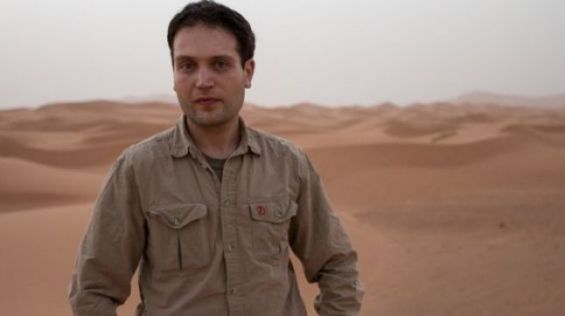When he was only 4 years old, Nizar Ibrahim dreamed of becoming a paleontologist. His passion for animals and particularly dinosaurs was «born through a book», the paleontologist, born September 8, 1982 to a Moroccan father and a German mother, told Yabiladi.
«I always had a great affinity for animals and wanted to understand everything. It is extraordinary to see the anatomical adaptations of certain species, such as whales that dive up to 3,000 meters deep», he said. The possibility of «understanding the biology of extinct species was also something compelling» to him.
«I saw above all an opportunity to explore the world and visit places that most people never see and to better understand the history of life and animals».
Growing up in Germany helped him a lot to pursue his passion for science and animals, thanks in particular to Germany’s museums, exhibitions and research centers. Nizar Ibrahim first studied geology and biology at the University of Bristol (UK) before joining the University of Dublin (Ireland) and its medical school for a PhD in paleontology.
His love for science then brought him to the United States, to the University of Chicago and its department of anatomy. Currently, he teaches vertebrate paleontology and comparative anatomy at the Department of Biology at the University of Detroit Mercy in Michigan.

But Nizar Ibrahim is above all a man of hands-on action. It was his research and that of his team that made it possible, in the 2010s, to make a discovery that questioned the established ideas about dinosaurs. «Morocco is one of the major geographic regions that I explore through my research, because the Kingdom is one of the richest countries in paleontological treasures in Africa, this forgotten continent of paleontology», he said.
A sad story that turned into a major discovery
It is in the area of Kem Kem, in southeastern Morocco, where Pr Ibrahim and his team made one of the greatest scientific discoveries of this century : The Spinosaurus aegyptiacus. «It all started more than 100 years ago with German paleontologist Ernst Stromer, who explored the Sahara in Egypt, discovering a world of dinosaurs and vertebrates that lived there», recalls the Moroccan-German scientist.
Works were then carried out, but the fossils and research were lost after the British air force bombed the Munich museum during the World War II. «The researcher also lost 2 of his three sons during the war. It was a tragedy for this researcher who opposed to the Nazi regime», Nizar Ibrahim said.
Decades after this tragedy, researchers tried to find Stromer's lost dinosaurs in different parts of the Sahara, and even in Morocco, as it was evident that the Saharan world of dinosaurs stretched from Egypt to Morocco.
«So I decided to rediscover this world of paleontological treasures, by starting my research projects in Morocco which was more accessible to me. There is a lot of outcrop and a lot of spaces to explore», he explained.

Over the past 12 years, his team discovered «all kinds of creatures» around the Kingdom, ranging from prehistoric crocodilians and giant fish to spectacular reptiles. «In all of this, and thanks to a local bone finder, we located a deposit with the skeleton of a Spinosaurus. It was the most famous discovery that we made, and recently, we even discovered the tail of the Spinosaurus which was the subject of the study published this year», he recalled proudly.
«This study even constituted a key moment, demonstrating that at least one dinosaur had an aquatic lifestyle.In addition to this, it is the largest predator in the world, exceeding the T-Rex in size.The fossils discovered in Morocco have also made it possible to reconstruct the only skeleton of a Spinosaurus in the world».
A national museum dedicated to discoveries made in Morocco
Through this discovery, the researcher and paleontologist explained his wish to «raise awareness among Moroccans on the importance of Morocco’s paleontologist heritage». «Spinosaurus could be an exhibit or a collection in a museum. This is the kind of fossil that everyone wants to see and have», he recalled, stressing that «all the fossils found are kept in Morocco, unlike what happens when fossils land in Europe or in the United States». «I decided to establish a research collection in Casablanca, Morocco, but it is difficult. The truth is that we need the help of the country to ensure that these treasures are preserved in good conditions», he pleaded.
The paleontologist also stresses the need for Morocco «to have a real national museum at some point». «I am not talking about local museums but a facility with a space for collections and conservation of future discoveries. It is a pity that we are still talking about it without it happening», he further declared.
«We took the first step with our research collection in Casablanca.The means are there but we must make investments.It would be a great tourist attraction.The Natural History Museum in London is one of the most visited places in the world, for example.If we have a museum where we exhibit the biggest predator in the world, tourists will come for that».
The researcher also promises several new discoveries that will be announced in the coming months, including one that will be published in 4 or 5 months. «We also have paleontological sites, not just for dinosaurs but for other prehistoric animals that we have identified thanks to an exploration operation. While due to Covid-19, field missions are practically impossible, we will come back to these sites as soon as we can travel again», he said.

The Moroccan-German scientist also tells us that he has plans to make a second documentary film on the discoveries of his team in Morocco. «There is immense global interest in this discovery and Morocco must jump at this opportunity and nurture this interest. As researchers, we made Morocco famous all over the world. Now, it's time for Morocco to take over», he explained, full of hope.





 chargement...
chargement...













